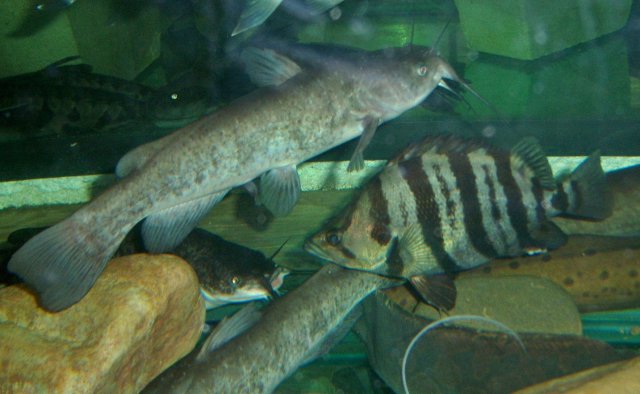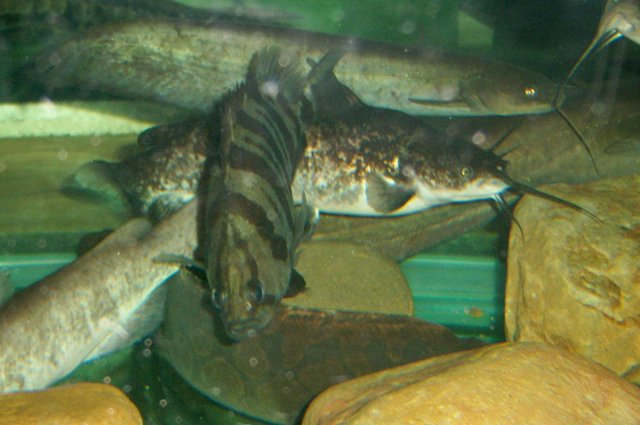What kind is my lonely datnoid?
- Thread starter thebiggerthebetter
- Start date
You are using an out of date browser. It may not display this or other websites correctly.
You should upgrade or use an alternative browser.
You should upgrade or use an alternative browser.
Got it about a year ago or more from Raymond Chan, $75, at ~5". It is ~8" currently. Loves his catfish farm pellets and cut fish.
Can you please tell me what kind it is and whether this growth rate is not too slow?
View attachment 1260582 View attachment 1260583
K krichardson
nice silver! D. polota. Any growth for them seems good. From what I have read and heard they are sometimes the slowest growing of the dats, especially considering how much smaller they typically grow to. 10" seems to be the average max, any silvers 12"+ are pretty rare
Update.
The little guy has grown well, currently at about 10". Loves its Ziegler pellets. It's gotten quite thick too.
Despite all that, I've been having a problem with it. As you might have noted, there is a small fuzzy white thing on its anal fin in the photo above. I've been having difficulty with it. It looks like kind of a fungus and it responds to Malachite Green treatments rather well. Yet soon after it makes a comeback.
The dat is in a system of four 240 gal tanks with hundreds of fish sharing the same water and none others have this problem.
Having done I think 3 or 4 Malachite Green treatments, I stopped doing them about 5-6 months ago to see what would happen long term. The fuzzy clumps came back slowly. They vary in number and size but are always present on the fish, which, notwithstanding, has been behaving like nothing's wrong.
Can anyone recommend anything? I cannot separate the fish right now due to not having a hospital tank at the moment plus chilly weather outside. I can give it baths, which is of course stressful for it. Or treat the entire system, but then I will be risking other fish well-being, just like I have done with the pretty harmful Malachite Green before, which miraculously didn't seem to affect other fish. I was very careful with it.
The little guy has grown well, currently at about 10". Loves its Ziegler pellets. It's gotten quite thick too.
Despite all that, I've been having a problem with it. As you might have noted, there is a small fuzzy white thing on its anal fin in the photo above. I've been having difficulty with it. It looks like kind of a fungus and it responds to Malachite Green treatments rather well. Yet soon after it makes a comeback.
The dat is in a system of four 240 gal tanks with hundreds of fish sharing the same water and none others have this problem.
Having done I think 3 or 4 Malachite Green treatments, I stopped doing them about 5-6 months ago to see what would happen long term. The fuzzy clumps came back slowly. They vary in number and size but are always present on the fish, which, notwithstanding, has been behaving like nothing's wrong.
Can anyone recommend anything? I cannot separate the fish right now due to not having a hospital tank at the moment plus chilly weather outside. I can give it baths, which is of course stressful for it. Or treat the entire system, but then I will be risking other fish well-being, just like I have done with the pretty harmful Malachite Green before, which miraculously didn't seem to affect other fish. I was very careful with it.
Last edited:
I can see the tuft in the photo but couldn't make out much in the video...anyhow this reminds me of the cottony growths that I would see on some brackish water fish such as archers and puffers that were kept in freshwater in some shops.Perhaps you could get something topical to dab on the growth or maybe even do a project;set up and acclimate the dat to a brackish tank and keep it there for a number of months and see if the growth reappears.
Adding some salt may help and getting the salinity up like krich mentioned. Trying a little hydrogen peroxide on a qtip to the area may help.
Thank you all, guys.
Yea, the dat was showing its good, clean left side. The other side, the right side had these cottony clumps at the time of shooting. That's why I included a small, a few seconds long footage at the very end of the video, where you can view the dat's mid-to-rear body part in between the rocks and see the growths. It's quick, so you might need to pause the video.
Right now it is having them on both sides.
There is clearly some patchy reddening appearing here and there, just like the clumps appear and disappear here and there too.
Are dats in general and the silver dat in particular a brackish water fish??
Has anyone experienced the same illness with their dats? Something that would respond to treatment and superficially go away but always come back and stay all the time, whilst the fish feeds, grows, and behaves as if nothing's wrong?
I can see the tuft in the photo but couldn't make out much in the video...anyhow this reminds me of the cottony growths that I would see on some brackish water fish such as archers and puffers that were kept in freshwater in some shops.Perhaps you could get something topical to dab on the growth or maybe even do a project;set up and acclimate the dat to a brackish tank and keep it there for a number of months and see if the growth reappears.
Yea, the dat was showing its good, clean left side. The other side, the right side had these cottony clumps at the time of shooting. That's why I included a small, a few seconds long footage at the very end of the video, where you can view the dat's mid-to-rear body part in between the rocks and see the growths. It's quick, so you might need to pause the video.
Right now it is having them on both sides.
There is clearly some patchy reddening appearing here and there, just like the clumps appear and disappear here and there too.
Are dats in general and the silver dat in particular a brackish water fish??
Has anyone experienced the same illness with their dats? Something that would respond to treatment and superficially go away but always come back and stay all the time, whilst the fish feeds, grows, and behaves as if nothing's wrong?
The silver dat as far as i know have been found in mostly brackish water. A few in freshwater. Not sure if they are captive bred now and if that makes a difference.
The spot could be lymph but does look like skin lesions on eels and sliver cars when kept in pure freshwater.
Hope it gets better!
The spot could be lymph but does look like skin lesions on eels and sliver cars when kept in pure freshwater.
Hope it gets better!




